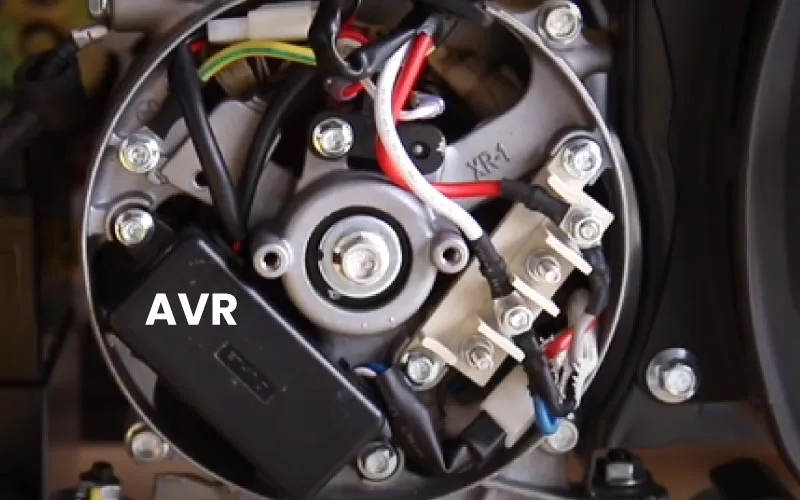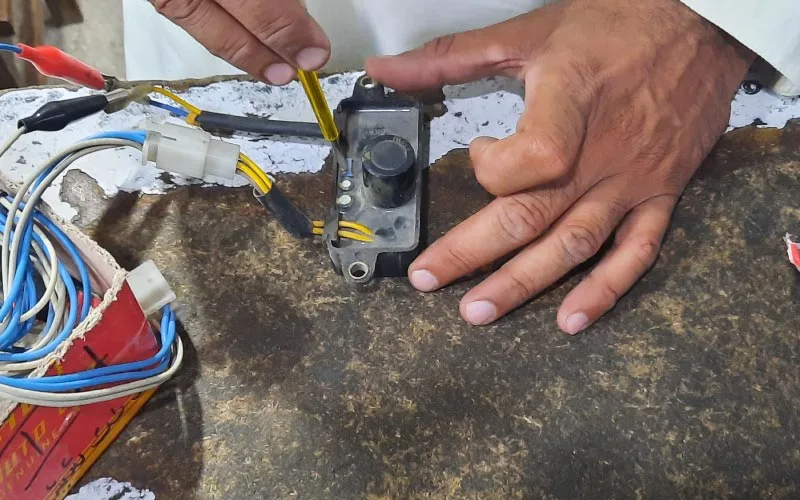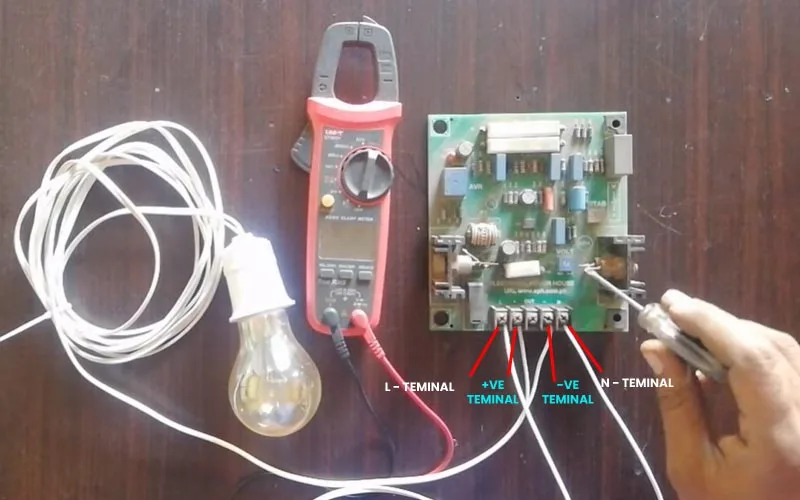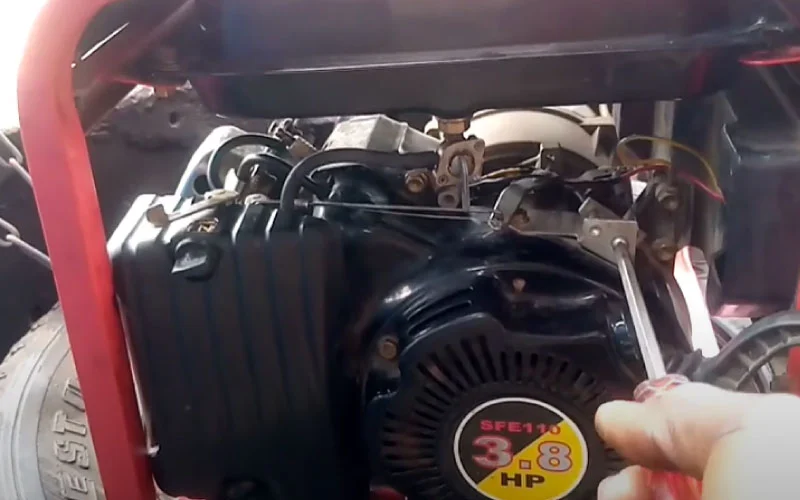How to Adjust Generator Voltage Without Hiring a Professional?
The non-calibrated voltage on a generator could not only hurt the control panel or instrument cluster of the generator but also melt down expensive voltage-sensitive appliances like chargers, UPS, refrigerators, etc.
This guide aims to provide you with a step-by-step guide about how to adjust generator voltage with the help of AVR or engine speed.
DISCLAIMER: The adjustment of voltage on 3-phase high voltage generators (4160 or 13500V) is a technical procedure and needs to be done correctly otherwise massive damage could occur.
We highly recommend consulting with a qualified generator technician who can observe the necessary factors like environment, nature of the appliances, maximum amperage, etc. precisely before doing the task.
How to Adjust Generator Voltage
Below are the most common ways to adjust the voltage of the generator without hiring a professional.
Method #1: How to Adjust Generator AVR?
Adjusting the voltage of the machine with the help of an AVR (automatic voltage regulator) is not only the safest but also the easiest way to calibrate the voltage of a generator without spending a penny.
Before starting the process let’s explore the safety instructions and tools you need to do the task.
Tools
Safety Instructions
Step By Step Process:
1. Remove the End/Stator Cover: Locate the stator or end cover of the generator and remove the two 7mm bolts with the help of the appropriate socket.
2. Locate the AVR: AVRs mostly have kidney or rectangular shapes depending on the type and brand of the generator you own.

3. Remove the Bolts of the AVR: With the help appropriate socket remove the two 7mm bolts that hold the AVR. Don’t disconnect the wires of the AVR.
4. Locate the Jeweler Screw for Voltage Adjustment: The back of the AVR contains a big capacitor and a jeweler screw exactly right to it.

5. Start the generator: Start the generator and leave it for a minute until the generator attains a uniform speed.
6. Adjust the AVR: Take a small flat head screw, rotate the jeweler screw/potentiometer counterclockwise or clockwise, and watch the volt meter. If the voltage remains the same, make sure to contact with professional generator technician.

NOTE: The above steps are only valid for the adjustment of the portable generator’s AVR, if you own a standby/whole house generator you need to follow the below steps.
How to Adjust AVR of Standby/Whole House Generator?
1. Locate the AVR of the standby generator; typically standby generator has AVRs on the top of the alternator terminal box or control panel. If you are struggling to locate the AVR give a read to the user manual.
2. Connect the AC (grid) supply to the “L” and “N terminals of the AVR, set the multimeter to AC voltage, and place the positive and negative probes on the top of “L” and “N” to make sure the AC supply is working fine.

3. Set the multimeter to the DC voltage and place the positive and negative probes on top of the positive and negative terminals of the AVR.
4. If the output DC voltage is not within the suitable range, you can turn the jeweler screw clockwise or counterclockwise to adjust the output excitation. After fixing the voltage to a certain value turn the voltage stabilizer to make sure there is no instability in the output.

NOTE: If you don’t have a multimeter, you can connect a bulb to the output of the AVR to measure the voltages with respect to the intensity of the light emitting from the bulb.
Recommended Guide: Bypassing the AVR of the Generator?
Method #2: Voltage Adjustment by Controlling the Engine Speed.
Since voltage is directly proportional to the engine’s speed, we can control the output by adjusting the engine’s speed.
Below is the step-by-step guide to tune the output voltage by controlling the speed of the rotor.
- Start the generator: Fire up the generator and wait for a few minutes till the generator attains a uniform speed.
- Locate the Speed Regulating Screw: In most cases, you will find the voltage regulator screw on the side/top of the air filter assembly.
- Adjust the Voltage: Take a screwdriver and rotate the voltage screw counterclockwise or clockwise as per the needs, Also monitor the output voltage from the voltmeter.

NOTE: The speed of the engine also can be adjusted by turning the idle screw.
Recommended Read: How to Test an AVR with a Multimeter?
What Is Standard Voltage for Generator?
120V, 220V, and 240V are considered the standard voltages for the generators. Small portable generators of 1 – 1.5kw mostly have 120V output, however, the large machines of more than 3kw provides 220V/240V outlet to run all of the heavy appliances like air conditioners, microwave, etc.
What Voltage Should a Generator Run At?
It depends on the type of machine you own, Most of the smallest portable generators provide 120V, however, the bigger machines usually provide 220V/240V.
Can You Adjust an AVR on a Generator?
Yes, you can adjust the AVR without hiring a professional, all you need to locate the AVR as per the type the machine and adjust it within a few minutes by following this section of the article.
What Happens if the Voltage Is Too Low?
Due to the low voltages, the power-sensitive appliances may malfunction or meltdown in the worst cases. Moreover, the motorized appliance couldn’t provide the desired output as well.
Recommended Guide: Causes and effects of Generator with low voltages
How Can the Generator Voltage Output Be Increased?
To increase the voltage of the generator you need to rotate the jeweler screw/potentiometer of the AVR clockwise or increase the engine’s speed by twinkling the idle screw or engine bolt.
Recommended Read: Generator produces overvoltage output
How Can the Generator Voltage Output Be Decreased?
For decreasing the voltage of the generator the jeweler screw/potentiometer needs to be turned counterclockwise or you can also play around with the engine’s speed by turning the idle screw or engine’s bolt.
Final Word
Though the voltage of the generator could be adjusted by twinkling the engine’s bolt or idle screw, still it requires some technical knowledge and we don’t recommend this method to newbies.
As per my experience adjusting the voltage with the help of AVR is the most accurate and reliable method for calibrating the voltages.
I hope you are now able to adjust the voltage of your generator without hiring a professional generator mechanic, if I have missed something, please let me know in the comment sections!
Frequently Asked Questions – [FAQs]
What Is the Best Way to Control the Output Voltage of a Generator?
As per our testing, Adjusting the AVR on a generator is the safest and most reliable way to control the voltage of the generator, though it takes a bit of time, still, you don’t have to play around with the technical things like engine speed, idle screw, etc.
Where Is the Voltage Regulator on a Generator?
In the case of the standby/whole house generators, the AVR could be found on the top of the alternator terminal or control box, however, in the case of the portable generator the AVR is mostly located inside the end/stator cover.
If you are struggling to locate the AVR, read the owner manual or consult with customer support.
Can a Generator Run Without AVR?
Yes but not recommended from our side as AVR is the only organ to control the output voltage of the generator.
Running a generator without an AVR will be a foolish act that will not only hurt the performance of the motorized appliances but also destroy them.
Can a Generator Run 120 and 240 at the Same Time?
It depends on the type of generator you own. Some generators are designed to handle both voltage levels simultaneously while others may require choosing one at a time. We recommend giving a read to the user manual and looking for the manufacturer’s guidelines.
Can a Generator Voltage Be Changed?
Yes, we can calibrate/adjust the output voltage of the AVRs by rotating the jeweler screw/potentiometer.
How Does AVR Control Generator Output?
AVR first sense the input voltage coming from the generator’s terminal and compare it with the stable reference (adjusted output voltage) to check for the error signal.
How Do I Know If My AVR Is Bad?
Unstable or no voltage is the main reason for a bad AVR.
Where Does an AVR Get Its Power?
AVR gets power from the main stator of the generator and stabilizes it before transforming it into the system.
Where Is the AVR on a Generac Generator?
The AVR of the standby Generac generator is mostly located inside the control panel, however, in the case of a portable generator you will find it inside the end/rotor cover.

Kashif has been a valuable asset to the electric generator industry for over 5 years. Now, As a skilled energy engineer, he’s been on the front lines of diagnosing problems, fixing broken parts, and performing routine maintenance tasks to keep generators running smoothly.
